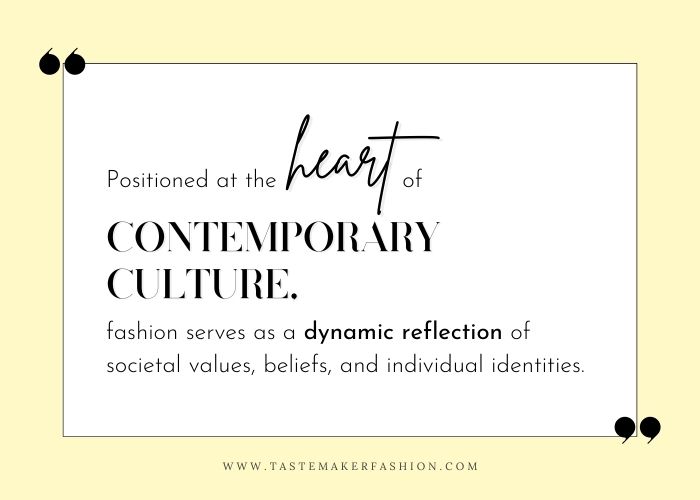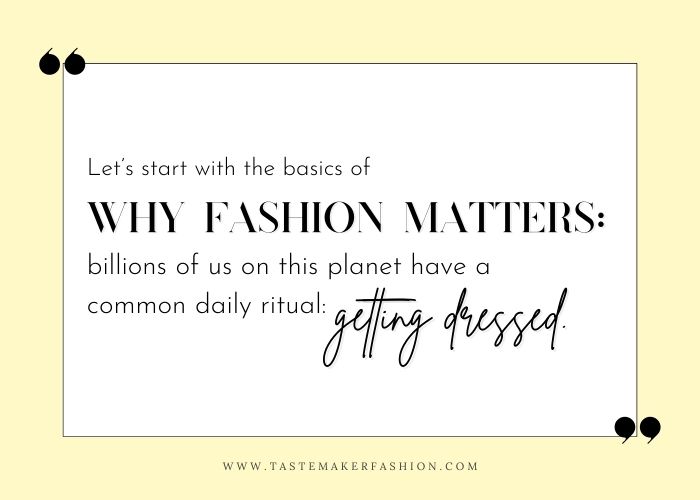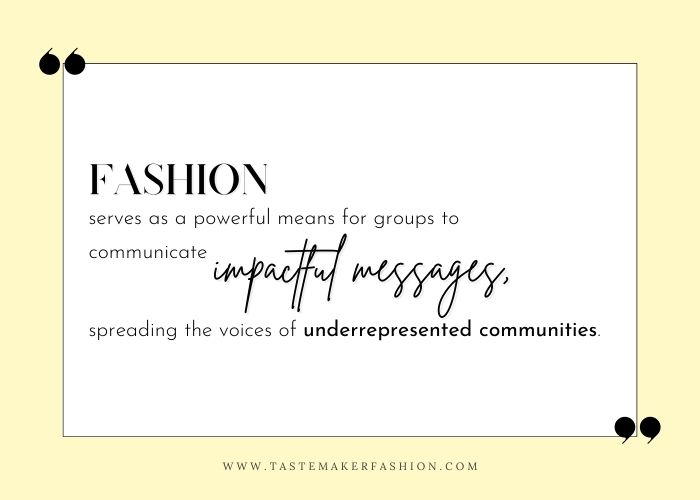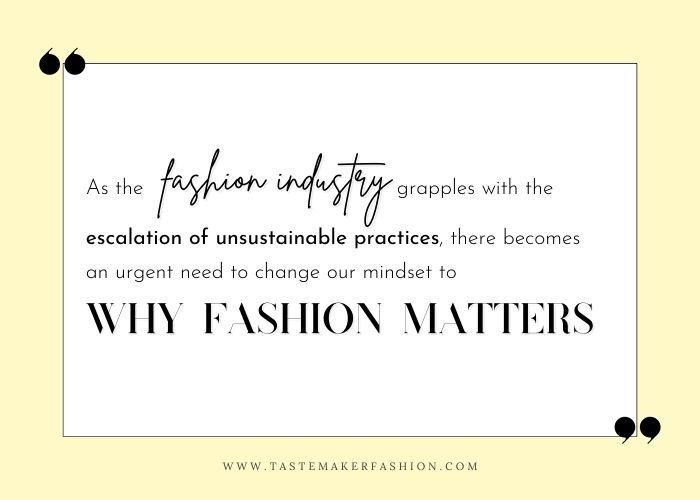
It’s a gut-punch when someone shrugs off fashion with a casual ‘I don’t like it’ or ‘I don’t care what I wear’. That’s because few elements are as universally woven into our lives as fashion. Beyond the act of dressing ourselves, why fashion matters extends far beyond the surface, capturing parts of our identity, societal structures, and even our impact on the planet.
From the role of clothing meeting our basic needs to its transformative influence on individual expression, the foundation of fashion is rich and multifaceted. We explore why fashion matters, delving into its historical, cultural, economic, and environmental dimensions. We not only aim to understand the complexities within the fashion industry but also ignite a conversation that reshapes our mindset, promoting a more ethical and sustainable future.
Understanding Why Fashion Matters
While fashion plays a vital role in our lives, it often faces the negative stigma of consumerism and materialism, being viewed as elitist, frivolous, and superficial. Mainstream media, including shows like Sex and the City, Gossip Girl, or The Devil Wears Prada, portrays the industry as a world of extravagant indulgence and entertainment. This representation downplays the fashion industry’s real significance in our everyday lives.
This perception has negatively affected an entire subculture, leading individuals interested in fashion to be dismissed and perceived as lacking seriousness or intelligence. As a fashion design major myself, I have personally navigated the challenge of dismissal from my peers, who did not understand why fashion matters. This experience underscores the widespread stereotypes surrounding the fashion industry and highlights a need for understanding its significance beyond superficial perceptions.
While it’s true that consumerism within the industry has negative consequences, fashion, at its core, is a channel for expression and connection. Positioned at the heart of contemporary culture, fashion serves as a dynamic reflection of societal values, beliefs, and individual identities. In essence, the fashion industry, despite its challenges, remains an indispensable and multifaceted aspect of our cultural landscape. The fashion industry demands our respect and maintains profound relevance in our lives, not only as a vibrant expression of individuality but also as a driving force shaping our future.

Fundamental Fashion
To begin with, let’s start with the basics of why fashion matters– billions of us on this planet have a common daily ritual: getting dressed. That’s because style isn’t just a statement; it’s also fulfilling one of our fundamental human needs.
Abraham Maslow, the renowned psychologist who mapped out Maslow’s Hierarchy of Needs, traces basic human needs starting from fundamental necessities to the pinnacle of self-actualization. Alongside water, food, air, and shelter, you’ll find clothing as part of the basis of human survival. When the weather turns extreme, the right clothing can insulate you against the cold or shield you from the sun.
Also, focusing on the bigger picture, clothing plays a vital role in your long-term well-being. It’s a barrier against infections, a guard against skin cancers, and a frontline defense against hygiene issues that can take a toll on your body. Without this protective layer, your body’s ability to optimally function is compromised. So the next time you slip on your favorite outfit, remember that fashion helps meet a fundamental human need for protection and well-being.
Shaping Society in Style
Ancient Civilization
Throughout history, fashion plays a pivotal role in influencing societal structures across diverse civilizations and cultures. In Ancient Rome, clothing served as a language conveying one’s position in society. The elite adorned themselves in togas of distinct colors and embellishments, signaling their elevated status. The lower class wore pileus, a felt hat that symbolized the journey from slavery to personal freedom.
Reigning Religion
Fashion transcended into religious clothing, where attire served as a powerful means of communication. Woven with rich color palettes and symbolism, religious attire went beyond a mere reflection of individual wearers. It also served as a visual declaration, representing the magnificence and steadfast authority of the Church, a pervasive and influential force over societies throughout early history.
The Renaissance
As history unfolded, dress codes revealed changing social and philosophical ideals. The early Renaissance influenced a shift from group-based aristocratic and religious classifications to individualism. People began to see themselves as unique individuals, no longer confined by the predetermined roles dictated by their social or religious affiliations. Fashion emerged as a powerful medium, and through personalized attire, it allowed individuals to break free from the confinement of traditional molds.
The Industrial Revolution
The 1800s witnessed a significant turning point for fashion during the Industrial Revolution. With the widespread adoption of mass production, fashion became accessible to people from different social backgrounds. This meant that individuals, regardless of their social status, could adopt the latest styles, aligning with the broader trend of consumerism during this significant period of change.
20th Century and Beyond
During the 20th Century, the impact of fashion transformed beyond the confines of our wardrobes; it wasn’t just about what you wore; it became a powerful force that shaped cultural trends. Every decade in the 1900s introduced new fashion styles, not only reflecting changes in society but also driving them. The evolution of why fashion matters has been a dynamic force, shaping societal structures and reflecting the ever-changing landscapes of history.
The Universal Language of Fashion
Fashion and Self-Expression
Why fashion matters goes beyond its fundamental role in aiding human survival and constructing societal frameworks; it emerges as another essential aspect of the human experience, through self-expression. Think of fashion as an avenue to your truest self, a window that opens the world into your identity, beliefs, and values. Embracing individuality in fashion allows us to celebrate our originality, fostering confidence in what sets us all apart.
From a psychological perspective, the way we choose to dress even has a significant influence on how others perceive us. The concept of “dressing for success” demonstrates that well-dressed individuals tend to project confidence, earning respect from their peers and contributing to more favorable outcomes in professional settings. This connection between clothing and perception highlights how fashion goes beyond personal expression, influencing how we’re viewed by society. Fashion is a universal language, speaking volumes about you without even saying a word.
Bridging Cultures and Communities
Fashion becomes a bridge that surpasses geographical and language boundaries, connecting people on a deeper level. Through the shared language of clothing, individuals from different backgrounds can find common ground, breaking down barriers and developing understanding. Interweaving culture with heritage, fashion amplifies the voices of marginalized communities, particularly where diversity might not be readily embraced.
By showcasing unique styles or traditional garments, fashion becomes a visual and impactful representation of cultural identity. It serves as a platform for storytelling, preserving traditions, and expressing the richness of heritage. Fashion not only becomes a form of self-expression but provides a sense of unity among diverse communities all around the world.

Fashion Activism
An empowering form of expression, fashion transcends its outward appearances to become intertwined in the socio-political landscape. More than just style, fashion emerges as a dynamic force that mirrors and responds to current events, reshaping how we perceive power, identity, and societal values. Fashion activism leverages clothing, accessories, hairstyles, and makeup as tools to advocate for social and environmental change. This use of fashion serves as a powerful means for groups to communicate impactful messages, spreading the voices of underrepresented communities.
Fashion Activism: Suffrage Movement
In the early 20th-century Suffrage Movement, fashion activists chose to wear white, green, and purple as a symbolic gesture of solidarity with women nationwide and as a declaration of their hard-earned rights. This palette continues to evolve in its representation, making a significant resurgence in contemporary events such as the Women’s March Protestors, which advocates for abortion rights in response to the overturning of Roe v. Wade in 2022.
Fashion Activism: Black Panther Party
Other social movements of the mid-60s and 1970s witnessed a surge of black liberation and pride as a response to racial injustices and discrimination in America. The Black Panther Party, as part of their campaigns, adopted a distinctive all-black ensemble inspired by military attire. Their uniform, consisting of black leather jackets, pants, sunglasses, and a beret, became an iconic symbol of their social movement. Black American women, rejecting white beauty standards, embraced their natural hair, infusing powerful African elements into American society.
Fashion Activism: Modern Day
Virgil Abloh, founder of Off-White and Louis Vuitton’s Men’s Artistic Director, stands out as a notable figure in contemporary fashion. Appointed in 2018 as one of the highest-profile Black designers in history, Abloh used his platform to support inclusion and diversity. His first show featured models from every continent (excluding Antarctica) and a rainbow runway, showing support for the LGBTQ community. His influence extends beyond fashion, as he set the stage for why fashion matters. Abloh advocated for the visibility and representation of marginalized individuals and ramping up activism in the fashion industry.
Fashion’s Economic and Environmental Footprint
Discussing the fashion industry inevitably brings attention to its profound impact on the global economy. As of 2023, the fashion industry is worth a staggering valuation of $1.7 trillion, consisting of a substantial 2% of the overall Gross Domestic Product (GDP). Employment-wise, the global fashion industry plays an important role to why fashion matters, providing jobs to over 300 million people. Remarkably, a significant 12.6% of the global population is actively engaged in the extensive process of producing clothing, shoes, and accessories, impacting various stages such as sourcing, manufacturing, designing, retail, and marketing.
Environmental Consequences
While the economic contributions of the fashion industry are undeniable, it is imperative to acknowledge both the positive and negative impacts. On the positive side, the industry generates substantial revenue and offers a multitude of job opportunities. However, the environmental toll is consequential, with the apparel sector alone accounting for 8% of the world’s greenhouse gas emissions and 20% of the total global water waste. An alarming 92 million tons of textile waste ends up in landfills annually, comprising at least 7% of the total global landfill space. The environmental damage underscores the urgent need to stop fast fashion within the fashion industry. Understanding the fashion industry’s dual impact is essential not only for grasping its role in our lives but also for preserving our planet.

Changing the Narrative to Why Fashion Matters
As the fashion industry grapples with the escalation of unsustainable practices, there becomes an urgent need to change our mindset to why fashion matters right now. Rather than dismissing fashion’s importance entirely, we need to shift the discussion toward a subject that resonates with a broader audience. While clothing is a necessity for everyone, it’s ironic that those who care about fashion are the ones taking meaningful steps to stop its issues, while others may shop without fully recognizing the consequences.
This stigma not only keeps environmental and ethical issues alive but also makes it difficult to inform the public about the urgent crisis at hand. To address this need for change, it is necessary to flip the narrative and encourage all consumers to understand why fashion matters when buying clothes. By emphasizing the significance of fashion to a wider audience, we can tip the scale towards a more positive and responsible landscape.
The transformation of the fashion industry requires serious involvement from policymakers and politicians who wield the power to implement substantial changes. They can enforce checks and balances by introducing laws and regulations that curb the industry’s unrestrained and destructive trajectory. By challenging our perspective on why fashion is fundamental, we can revolutionize the industry towards a more responsible landscape.
–
Fashion, ingrained in the very fabric of our lives, plays an indispensable role in meeting fundamental human needs, shaping societal structures, and serving as a compelling means of self-expression. However, understanding why fashion matters reaches beyond the confines of our closets, with environmental implications demanding our attention and action.
While acknowledging the challenges forced by unsustainable practices, we must not dismiss the significance of fashion. Instead, let us revise the conversation, recognizing the transformative potential of this cultural powerhouse and why fashion matters. By fostering a broader understanding and encouraging conscious choices, we can tip the scales toward a more responsible landscape. The future of fashion lies not just in what we wear but in how we redefine the narrative, ensuring it continues to reflect our evolving values.
